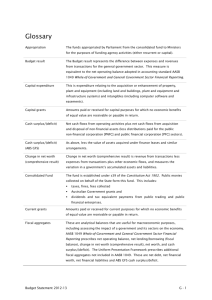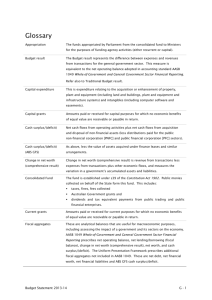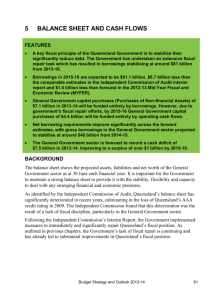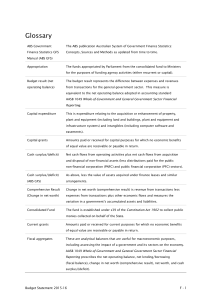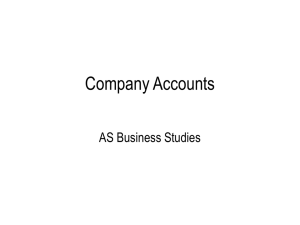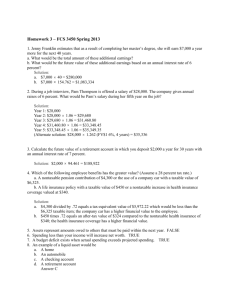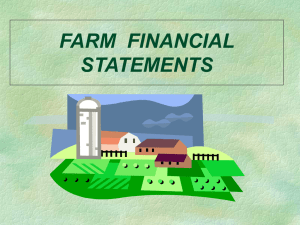6. Balance Sheet and Cash Flows
advertisement
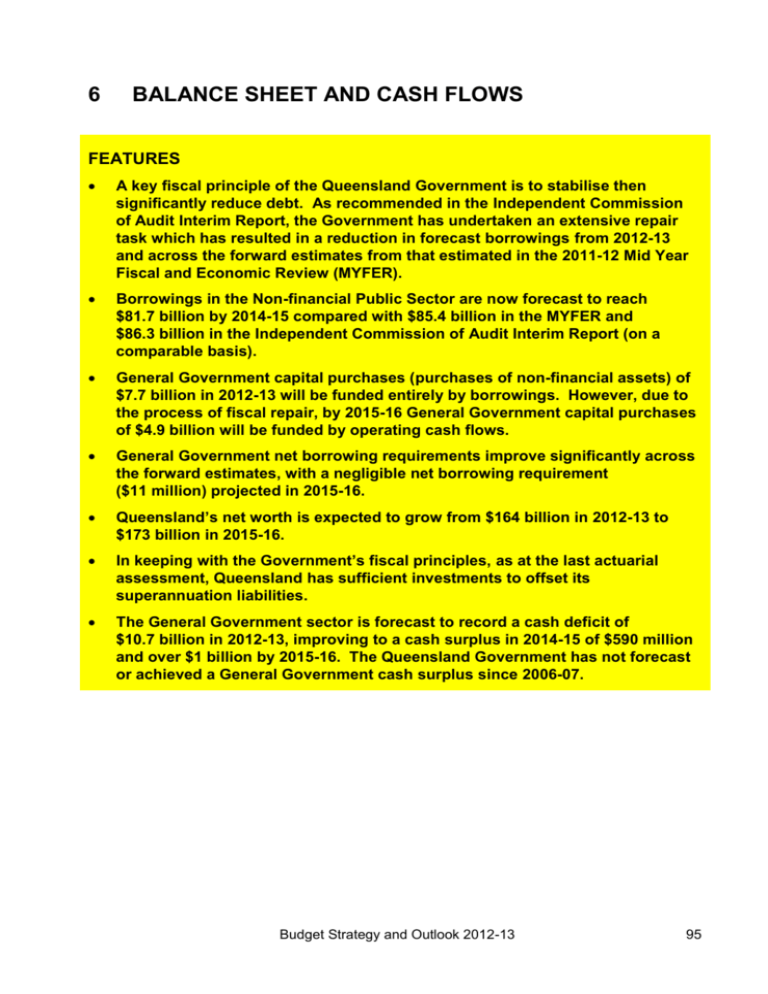
6 BALANCE SHEET AND CASH FLOWS FEATURES A key fiscal principle of the Queensland Government is to stabilise then significantly reduce debt. As recommended in the Independent Commission of Audit Interim Report, the Government has undertaken an extensive repair task which has resulted in a reduction in forecast borrowings from 2012-13 and across the forward estimates from that estimated in the 2011-12 Mid Year Fiscal and Economic Review (MYFER). Borrowings in the Non-financial Public Sector are now forecast to reach $81.7 billion by 2014-15 compared with $85.4 billion in the MYFER and $86.3 billion in the Independent Commission of Audit Interim Report (on a comparable basis). General Government capital purchases (purchases of non-financial assets) of $7.7 billion in 2012-13 will be funded entirely by borrowings. However, due to the process of fiscal repair, by 2015-16 General Government capital purchases of $4.9 billion will be funded by operating cash flows. General Government net borrowing requirements improve significantly across the forward estimates, with a negligible net borrowing requirement ($11 million) projected in 2015-16. Queensland’s net worth is expected to grow from $164 billion in 2012-13 to $173 billion in 2015-16. In keeping with the Government’s fiscal principles, as at the last actuarial assessment, Queensland has sufficient investments to offset its superannuation liabilities. The General Government sector is forecast to record a cash deficit of $10.7 billion in 2012-13, improving to a cash surplus in 2014-15 of $590 million and over $1 billion by 2015-16. The Queensland Government has not forecast or achieved a General Government cash surplus since 2006-07. Budget Strategy and Outlook 2012-13 95 BACKGROUND The balance sheet shows the projected assets, liabilities and net worth of the Government as at 30 June each financial year. It is important for the Government to maintain a strong balance sheet to provide it with the stability, flexibility and capacity to deal with any emerging financial and economic pressures. As identified by the Independent Commission of Audit in its Interim Report, Queensland’s balance sheet has significantly deteriorated in recent years, culminating in the loss of Queensland’s AAA credit rating in 2009. The Independent Commission found that this deterioration was the result of a lack of fiscal discipline, particularly in the General Government sector. The Independent Commission indicated that immediate and significant fiscal repair was required in order to improve Queensland’s fiscal position and to avoid potential future credit downgrades. As outlined in previous chapters, the Government has undertaken a task of fiscal repair, leading to substantial improvements in Queensland’s fiscal position. 96 Budget Strategy and Outlook 2012-13 BALANCE SHEET Table 6.1 provides a summary of the key balance sheet measures for the General Government sector. Table 6.1 General Government sector: summary of budgeted balance sheet1 2011-12 Budget 2 $ million 2011-12 Est. Act. $ million 2012-13 Budget $ million 58,420 56,926 57,523 59,088 61,373 63,118 189,616 180,333 185,320 189,843 193,042 195,601 248,035 237,259 242,843 248,930 254,414 258,719 Borrowings, advances and deposits 33,925 30,306 41,548 45,752 46,361 46,384 Superannuation liability 25,764 25,461 25,721 25,893 25,918 25,781 Other provisions and liabilities 11,325 12,225 11,774 12,366 12,990 13,586 Total Liabilities 71,013 67,991 79,043 84,011 85,270 85,751 Net Worth 177,023 169,268 163,800 164,919 169,145 172,968 Net Financial Worth (12,593) (11,065) (21,520) (24,924) (23,897) (22,633) Net Financial Liabilities 31,578 28,291 38,476 42,179 41,712 41,081 Net Debt (1,528) (5,384) 5,120 8,280 7,865 6,935 Financial assets Non-financial assets 3 Total Assets 2013-14 2014-15 Projection Projection $ million $ million 2015-16 Projection $ million Notes: 1. Numbers may not add due to rounding. 2. Numbers have been restated where subsequent changes in classification have occurred. 3. For Uniform Presentation Framework purposes, the State’s assets are classed as either financial or non-financial assets. Budget Strategy and Outlook 2012-13 97 Financial assets The General Government sector holds the full equity of the State’s public enterprises, principally its shareholding in Government-owned corporations (GOCs) but also Public Financial Corporations like Queensland Treasury Corporation (QTC), in much the same manner as the parent or holding company in a group of companies. The estimated net investment in public enterprises is included in the General Government sector’s financial assets. Financial assets of $56.926 billion are estimated for 2011-12, $1.494 billion lower than originally budgeted. This change is primarily the result of the downward revaluation of Queensland Rail Infrastructure assets at 30 June 2011 which carries into 2011-12. In the year to 30 June 2013, financial assets are projected to increase by $597 million attributable principally to increased investment in assets set aside to meet future employee liabilities including superannuation. Chart 6.1 shows projected General Government sector financial assets by category at 30 June 2013. Investments held to meet future liabilities, including superannuation and long service leave, comprise the major part of the State’s financial assets. Chart 6.1 Projected General Government financial assets by category at 30 June 2013 Investments in other public sector and other entities 29.8% Investments, loans and placements 61.2% 98 Receivables 6.9% Cash, deposits and advances 2.1% Budget Strategy and Outlook 2012-13 Non-financial assets General Government non-financial assets are projected to total $180.333 billion at 30 June 2012, $9.3 billion lower than forecast at the 2011-12 Budget. This reduction reflects the flow through of revaluations, primarily for land and road infrastructure. Changes in non-financial assets occur for a number of reasons including: construction and purchase of assets, either to replace existing assets or provide additional capacity for the State to deliver services revaluations of assets required under accounting standards depreciation and disposals of assets. Non-financial assets in the year ending 30 June 2013 are expected to grow by $4.987 billion over the 2011-12 estimated actuals to be $185.32 billion at 30 June. These assets consist primarily of land and other fixed assets of $179.169 billion, the majority of which are roads, schools, hospitals and other infrastructure used to provide services to Queenslanders. Other non-financial assets of $6.151 billion held by the State include prepayments and deferred tax assets relating to income tax equivalents collected primarily from GOCs. Since the 1990s, the Queensland Government has invested in new infrastructure at levels well beyond that of the other states. General Government purchases of non-financial assets per capita have far exceeded the average of the other states and territories for well over a decade (refer Chart 6.2). As a consequence, the State’s borrowings have increased substantially, particularly in recent years. Budget Strategy and Outlook 2012-13 99 Chart 6.2 General Government purchases of non-financial assets, 1994-95 to 2012-13 Purchases of non-financial assets have increased further as a result of the flood and cyclone disasters of 2010, 2011 and 2012 which required the extensive replacement of infrastructure. Chart 6.3 indicates the proportion of the General Government capital program that has been spent on restoration of assets following disasters. Chart 6.3 Proportion of General Government capital purchases spent on disaster restoration 100 Budget Strategy and Outlook 2012-13 The level of purchases of non-financial assets for the General Government sector is forecast to wind back from just over $8 billion in 2011-12 to just under $5 billion in 2015-16. Liabilities General Government Sector General Government liabilities of $67.991 billion in 2011-12 are $3.022 billion lower than budgeted. This is primarily the result of a decrease in forecast borrowings as a result of an improved fiscal balance in 2011-12. Total liabilities in the General Government sector in 2012-13 are budgeted to increase over 2011-12 by $11.052 billion. This primarily reflects the deterioration in the fiscal balance over this period. Liabilities relating to employee entitlements (principally superannuation and long service leave) are projected to total $30.704 billion at 30 June 2013, a modest 1.1% increase on the 2011-12 estimated actual. The State’s superannuation liability can be seen to stabilise and begin to decline over the forward estimates primarily as a result of the defined benefit fund being closed to new entrants from 2009. At the time of preparing the 2012-13 Budget, the latest AASB119 valuation of the State’s defined benefit superannuation liability was not available. General Government borrowings of $41.309 billion are forecast for 2012-13, an increase of $11.292 billion over 2011-12. This increase primarily reflects capital purchases of $7.653 billion, equity injections to Public Non-financial Corporations of $281 million and an operating cash deficit of $3.341 billion. The level of General Government borrowings stabilises at $46 billion in 2014-15 primarily as a result of the Government’s savings and revenue measures. Stabilisation of debt is crucial to the Government’s aim of restoring the AAA credit rating. Over the Budget and forward estimates period, total General Government net borrowings of $16.33 billion are planned to fund the $25.118 billion worth of capital projects in the General Government sector and $730 million worth of equity injections to the Public Non-financial Corporations sector to support expansion of the State’s passenger rail infrastructure. The remainder of the liabilities balance consists of payables and other liabilities such as unearned revenue and provisions. The composition of the General Government sector’s liabilities is illustrated in Chart 6.4. Budget Strategy and Outlook 2012-13 101 Chart 6.4 Projected General Government liabilities by category at 30 June 2013 Superannuation liability 32.5% Payables 4.2% Other liabilities 4.4% Other employee benefits 6.3% Borrowing1 52.6% 1. Includes borrowing, advances and deposits Non-financial Public Sector Borrowings Non-financial Public Sector borrowings of $62.672 billion are forecast for 2011-12, around the level forecast at the 2011-12 MYFER. Non-financial Public Sector borrowings of $73.717 billion are forecast for 2012-13, an increase of $11.045 billion over 2011-12, reflecting the increased borrowing in the General Government sector. The Government is forecasting to borrow $4.6 billion less by 2014-15 than outlined in the Independent Commission of Audit. Borrowing is now forecast to reach $81.749 billion in 2014-15 compared with $86.326 billion in the Independent Commission of Audit. As outlined in Chart 6.5, the Government is now forecasting to fund a smaller proportion of its capital program from borrowings. Over the period 2011-12 to 2014-15 the Government is forecast to borrow to meet around 58% of its capital purchases. This compares to 74% of the capital program being funded by borrowings in the Independent Commission of Audit. 102 Budget Strategy and Outlook 2012-13 Chart 6.5 Proportion of the capital program funded by borrowings 2011-12 MYFER to 2012-13 Budget1 120% 2011-12 MYFER 2012-13 Budget 100% 80% 60% 40% 20% 0% 2011-12 1. 2012-13 2013-14 2014-15 Where the ration exceeds 100% it indicates that borrowing is being undertaken for non-capital purposes. Net financial worth The net financial worth measure is an indicator of financial strength. Net financial worth is defined as financial assets less all existing and accruing liabilities. Financial assets include cash and deposits, advances, financial investments, loans, receivables and equity in public enterprises. The net financial worth measure is broader than the alternative measure – net debt – which measures only cash, advances and investments on the assets side and borrowings and advances on the liabilities side. The net financial worth of the General Government sector for 2012-13 is forecast at negative $21.52 billion. The decrease in net financial worth since 2011-12 ($10.455 billion) is primarily the result of the increase in borrowings over the same period. Net financial worth is expected to stabilise over the forward estimates period as borrowings level out as a consequence of the Government’s fiscal repair. Budget Strategy and Outlook 2012-13 103 Net financial liabilities Net financial liabilities are total liabilities less financial assets, other than equity investments in other public sector entities. This measure is broader than net debt as it includes significant liabilities, as well as borrowings (for example, accrued employee liabilities such as superannuation and long service leave entitlements). The net financial liabilities of the General Government sector for 2012-13 are forecast at $38.476 billion, $10.185 billion higher than 2011-12 consistent with the increase in borrowings over this period. Net financial liabilities decrease after 2014-15 as borrowings stabilise. Net worth The net worth, or equity, of the State is the amount by which the State’s assets exceed its liabilities (which is equivalent to General Government net worth). This is the value of the investment held on behalf of the people of Queensland by public sector instrumentalities. Changes in the State’s net worth occur for a number of reasons including: operating surpluses (deficits) that increase (decrease) the Government’s equity revaluation of assets and liabilities as required by accounting standards. For example, the Government’s accruing liabilities for employee superannuation and long service leave are determined by actuarial assessments movements in the net worth of the State’s investments in the Public Non-financial Corporations and Public Financial Corporations sectors gains or losses on disposal of assets. Government agencies routinely buy and sell assets. Where the selling price of an asset is greater (less) than its value in an agency’s accounts, the resultant profit (loss) affects net worth. The net worth of the General Government sector in 2011-12 is forecast to be $169.268 billion. This is less than forecast in the 2011-12 Budget by $7.755 billion primarily due to the downward revaluations of land and road infrastructure and other assets in both 2011 and 2012, offset in part by an improved fiscal deficit since the 2011-12 Budget. Net worth is forecast to decrease further by $5.468 billion to $163.8 billion in 2012-13 due primarily to the fiscal deficit for that year. From 2013-14, net worth is projected to steadily increase mainly as a result of improved operating results and from fiscal repair. 104 Budget Strategy and Outlook 2012-13 Net debt Net debt is the sum of advances received and borrowings less cash and deposits, advances paid and investments, loans and placements. Queensland maintains a good net debt position due, in part, to the way it has structured its financial investments held to cover long term liabilities, including superannuation. Net debt for the General Government sector in 2011-12 is forecast to be negative $5.384 billion increasing to positive $5.12 billion in 2012-13 as a result of increased borrowings in that year. The Independent Commission of Audit considers: ‘As the net debt measure includes investments, it takes account of the large investments Queensland uses to offset its superannuation liability, it does not take account of the liabilities. Under existing Government policy, these investments are held to meet the State’s superannuation liability. Because these investments are not available to reduce gross debt, net debt is not a suitable metric to target in setting an appropriate fiscal strategy… The Commission consider that the most suitable measure of debt is the concept of net financial liabilities..’1 The Government has adopted the net financial liabilities to revenue ratio as one of its fiscal principles. 1 Pages 20 and 21 of the Queensland Commission of Audit Interim Report June 2012. Budget Strategy and Outlook 2012-13 105 CASH FLOWS The cash flow statement provides information on the Government’s estimated cash flows from its operating, financing and investing activities. The cash flow statement records estimated cash payments and cash receipts and hence differs from accrued revenue and expenditure recorded in the operating statement. In particular, the operating statement often records revenues and expenses that do not have an associated cash flow (for example, depreciation expense). The timing of recognition of accrued revenues or expenses in the operating statement may differ from the actual cash disbursement or receipt (for example, tax equivalents). A reconciliation between the cash flows from operations and the operating statement is provided in Table 6.2. The cash flow statement also records cash flows associated with investing and financing activities that are otherwise reflected in the balance sheet. For example, purchases of capital equipment are recorded in the cash flow statement and impact on the balance sheet through an increase in physical assets. The cash flow statement provides the cash surplus (deficit) measure which is comprised of the net cash flow from operating activities plus the net cash flow from investment in non-financial assets (or physical capital). The Australian Bureau of Statistics Government Finance Statistics (GFS) cash surplus (deficit) is derived by including the initial increase in liability at the inception of finance leases in the cash surplus (deficit). This measure is also used to derive the Loan Council Allocation nomination, provided in Chapter 9. The General Government cash deficit of $4.836 billion in 2011-12 is $3.079 billion lower than that forecast at the time of the 2011-12 Budget and $2.078 billion lower than the 2011-12 MYFER. This is mainly due to the receipt of advance Australian Government natural disaster grant funding coupled with lower than expected payments for goods and services mainly in the areas of health and education. A cash deficit of $10.676 billion is forecast in 2012-13 for the General Government sector, with the cash deficit forecast to decline significantly over the forward estimates, returning to surplus in 2014-15 and 2015-16. This is the first time since 2006-07 that the Government has forecast or achieved a cash surplus in the General Government sector. The major factors contributing to the improved cash position are improved net inflows from operating activities as a result of Government’s efforts in relation to the fiscal repair task. Total General Government capital purchases of $7.653 billion are budgeted for 2012-13 and, over the period 2012-13 to 2015-16, capital expenditure is expected to total $25.118 billion in the General Government sector. 106 Budget Strategy and Outlook 2012-13 RECONCILIATION OF OPERATING CASH FLOWS TO THE OPERATING STATEMENT Table 6.2 provides a reconciliation of the cash flows from operating activities to the operating result for the General Government sector. Table 6.2 General Government sector: Reconciliation of cash flows from operating activities to accrual operating activities1 Revenue from transactions Plus/(less) movement in tax equivalent and dividend receivables Plus GST receipts Plus/(less) movement in other receivables 2011-12 Est. Act. $ million 45,707 2012-13 Budget $ million 42,224 167 1 2,602 2,506 (328) (359) Equals cash receipts from operating activities 48,148 44,372 Expenses from transactions 46,021 48,518 Depreciation and amortisation expense (2,765) (3,086) Accrued superannuation expense (Less) non-cash items (2,297) (2,269) Accrued employee entitlements (641) (636) Other accrued costs (151) (206) 2,138 2,002 299 2,649 574 2,524 Plus superannuation benefits paid – defined benefit Plus/(less) movement in employee entitlement provisions Plus/(less) GST paid Plus/(less) movement in other provisions and payables Equals cash payments for operating activities (72) 292 45,181 47,714 Note: 1. Numbers may not add due to rounding. The main difference between the accrual operating statement and the cash flow relates to the timing of cash payments and receipts and their recognition in accrual terms and the inclusion of non cash expenses and revenues. The largest difference is on the expenses (expenditure) side, with large non cash expenses associated with depreciation and superannuation. Differences due to the timing of receipt or payment of amounts are recorded as either a receivable or payable in the balance sheet. Budget Strategy and Outlook 2012-13 107 108 Budget Strategy and Outlook 2012-13
